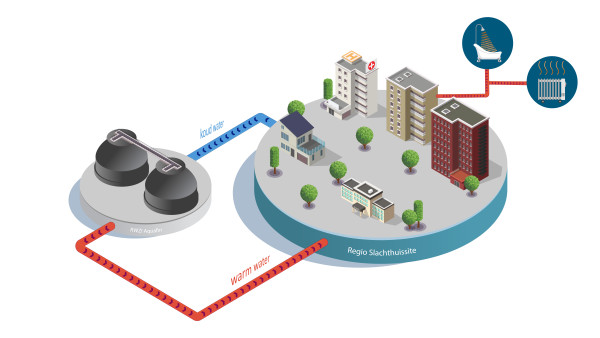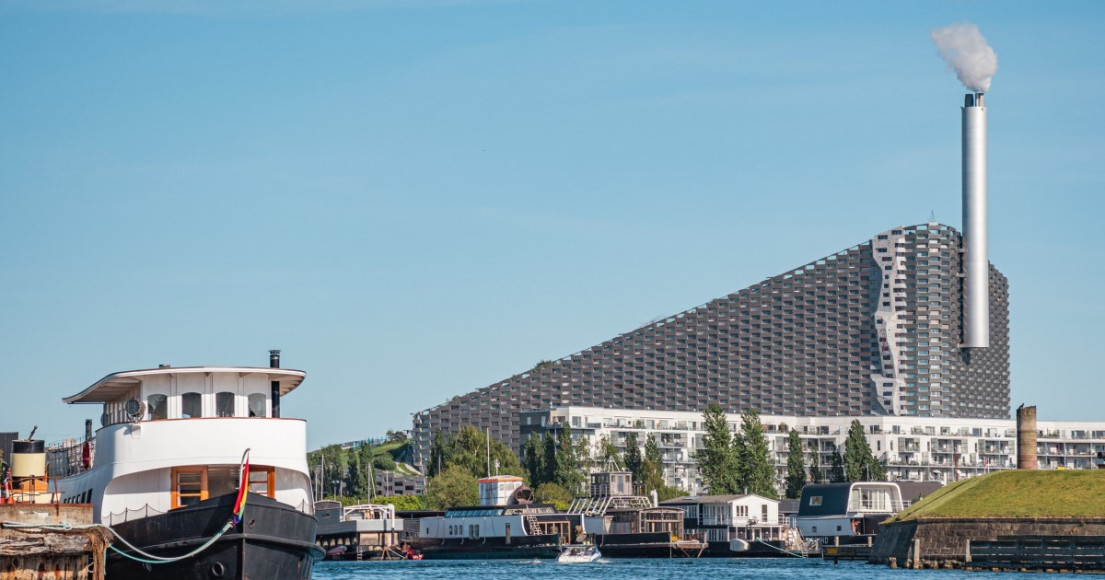District heating networks play a crucial role in the transition to a sustainable energy supply. This smart infrastructure allows heat to be shared and optimally utilised, resulting in lower CO2 emissions and more efficient energy use. But what exactly are district heating networks? And how do they contribute to a greener future?
What is a district heating network?
Simply put, a district heatibg network is a network of underground pipes that transport heat from point A to point B. It is similar to a central heating system at home, but on a huge scale. The heart of a heat network is located at a large central spot, where heat is generated from different sources. These sources can range from geothermal, which extracts heat from the earth, to waste heat from industrial processes in factories. What is unique about district heating networks is that they capture this valuable heat, which would otherwise go to waste, and transport it to buildings and houses that need heating or hot water. This without the intervention of a central boiler.
So instead of each user having to maintain their own individual heating system, a district heating network makes it possible to benefit from heat collectively. Insulated pipes carry heat safely over long distances to different buildings and houses, and so different consumers in an entire city or even an entire region can enjoy comfortable heat without depending on fossil fuels.

The benefits of heat networks
- Making heat supply more sustainable: District heating networks play a key role in reducing CO2 emissions and accelerating the energy transition. By using renewable heat sources, or heat that would otherwise go to waste, heat networks can help reduce dependence on fossil fuels and promote renewable energy.
- Efficient use of waste heat: Industries and other heat producers often produce large amounts of waste heat that would otherwise go to waste. District heating networks provide an opportunity to harness this waste heat and transport it to buildings and households in need of heat.
- Savings on individual heating systems: By using a collective heating network, people can do without their individual heating systems. This leads to cost savings as there is no need for maintenance, replacement and fuel purchases for individual systems.
- Flexibility and future-proofing: District heating networks can be easily adapted to changing heat sources in the future. For example, if the heat source shifts from fossil fuels to renewable energy sources, heat networks can support this transition without users having to adapt their installations.
District heating networks in practice
A good application of a district heating network is the heat concept for (the region around) the Slachthuissite in Antwerp. The city of Antwerp, Fluvius and Aquafin in fact joined forces to realise a sustainable heat network in that region, with the Deurne-Schijnpoort sewage treatment plant acting as a heat source. To investigate whether it is technically and economically feasible to use waste heat from the sewage treatment plant as a sustainable heat source, we conducted a feasibility and concept study. We also looked at different ways of heat production and phasing, in order to design an optimal system.
We then prepared a business case and analysed what the impact would be on the heat production system in case neighbouring expansion areas were connected. With the results of this project, we laid a solid foundation for the implementation of a sustainable heat production system based on waste heat from the sewage treatment plant. All this to reduce CO2 emissions, increase energy efficiency and promote a circular economy in the city of Antwerp.
District heating network as a renewable energy source?
District heating networks play a crucial role in achieving a sustainable energy supply. By using different sustainable heat sources and efficiently transporting heat to different customers, heat networks help save energy and reduce CO2 emissions. However, it is important to note that currently heat often comes from companies that still use fossil fuels for their production processes. While the use of heat networks currently offsets some of the loss, it is only truly 100% sustainable if this heat is also produced in a sustainable way.
Nevertheless, with their flexibility and scalability, district heating networks remain a smart choice for the future. They provide cities and communities with comfortable heat in a sustainable and efficient manner, forming a key pillar in our transition to a sustainable society. By focusing on sustainable heat sources, such as geothermal, biomass, and residual heat from industrial processes generated in a sustainable manner, heat networks can fully realise their potential as a sustainable energy solution.
Want to know more about sustainable energy supply?
I am happy to help!





